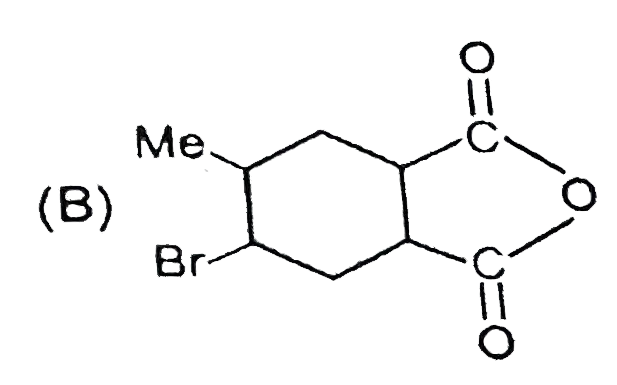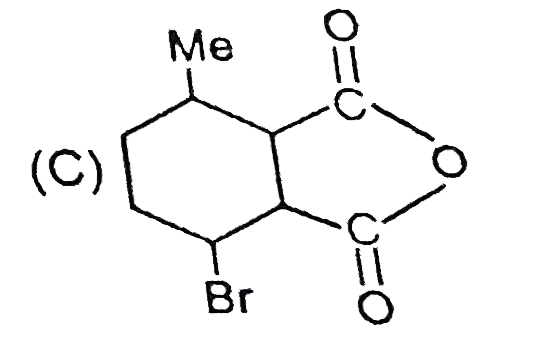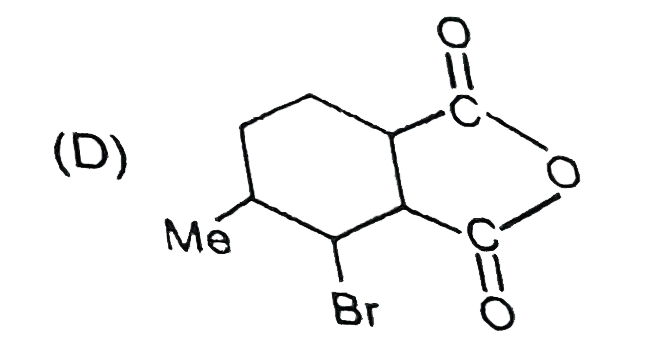Correct structure of 3-Bromo-4-methylcyclohexane-1,2-dicarboxylic anhydride




To determine the correct structure of 3-Bromo-4-methylcyclohexane-1,2-dicarboxylic anhydride, we can follow these steps:
Step 1: Identify the Base Structure
The base structure is cyclohexane, which is a six-membered carbon ring.
Step 2: Identify the Substituents
- 3-Bromo indicates that a bromine (Br) atom is attached to the third carbon of the cyclohexane ring.
- 4-Methyl indicates that a methyl (CH₃) group is attached to the fourth carbon of the cyclohexane ring.
- 1,2-Dicarboxylic anhydride indicates that there are two carboxylic acid groups (COOH) at the first and second positions, which are converted into an anhydride (removal of water).
Step 3: Draw the Cyclohexane Ring
Start by drawing a hexagonal structure representing cyclohexane.
Step 4: Add the Dicarboxylic Anhydride
At the 1 and 2 positions of the cyclohexane, we will add the dicarboxylic anhydride structure. The anhydride can be represented as follows:
- For the first carbon (C1) and second carbon (C2), we will have a structure of -C(=O)-O-C(=O)-.
Step 5: Add the Bromine and Methyl Groups
- At the third carbon (C3), attach a bromine atom.
- At the fourth carbon (C4), attach a methyl group.
Step 6: Verify the Structure
Make sure that:
- The bromine is on the third carbon.
- The methyl group is on the fourth carbon.
- The anhydride structure is correctly placed at the first and second positions.
Final Structure
The final structure should look like this:
O∣∣∣∣∣∣O=C−CCCBr∣∣∣∣∣∣CH₃CC C
Where:
- The top part represents the anhydride.
- The bromine is on the third carbon.
- The methyl group is on the fourth carbon.
The base structure is cyclohexane, which is a six-membered carbon ring.
- 3-Bromo indicates that a bromine (Br) atom is attached to the third carbon of the cyclohexane ring.
- 4-Methyl indicates that a methyl (CH₃) group is attached to the fourth carbon of the cyclohexane ring.
- 1,2-Dicarboxylic anhydride indicates that there are two carboxylic acid groups (COOH) at the first and second positions, which are converted into an anhydride (removal of water).
Start by drawing a hexagonal structure representing cyclohexane.
At the 1 and 2 positions of the cyclohexane, we will add the dicarboxylic anhydride structure. The anhydride can be represented as follows:
- For the first carbon (C1) and second carbon (C2), we will have a structure of -C(=O)-O-C(=O)-.
- At the third carbon (C3), attach a bromine atom.
- At the fourth carbon (C4), attach a methyl group.
Make sure that:
- The bromine is on the third carbon.
- The methyl group is on the fourth carbon.
- The anhydride structure is correctly placed at the first and second positions.
The final structure should look like this:
O∣∣∣∣∣∣O=C−CCCBr∣∣∣∣∣∣CH₃CC C
Where:
- The top part represents the anhydride.
- The bromine is on the third carbon.
- The methyl group is on the fourth carbon.
Topper's Solved these Questions
Similar Questions
Write the structure of 3-Bromo-2-methylprop-1-ene
View SolutionWrite the structure of 1-Bromo-4-chlorobut-2-ene
View SolutionThe correct structure of 2-Ethyl-3-methylhexa-1,4-diene:
View SolutionThe correct structure of 6-Amino-4-hydroxycylohex-2-ene-1-sulphonic acid.
View SolutionWrite the structural formulae of the following :
Benzene-1, 4-dicarboxylic acid
View SolutionWrite the structural formulae of the following :
Benzene-1, 4-dicarboxylic acid
View SolutionWrite the structural formulae of the following :
Benzene-1, 4-dicarboxylic acid
View SolutionWrite down structure of the following compounds:
2-methyl-2-propene-1,1-dicarboxylic acid
View SolutionTwo stereoisomers (cis and trans) or 3,4-Dibromocyclopentane-1 , 1-Dicarboxylic acid undergo decarboxylation, find out the total number of products formed.
View SolutionThe correct structure of 6-Ethyl-2,3,5-trimethylnonane is:
View Solution
